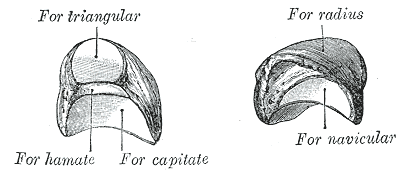Lunate bone
|
|
The lunate bone (os lunatum; semilunar bone) is a bone in the human hand that may be distinguished by its deep concavity and crescentic outline. It is situated in the center of the proximal row of the carpus, or wrist, between the navicular bone and triangular bone. The superior surface, convex and smooth, articulates with the radius. The inferior surface is deeply concave, and of greater extent from before backward than transversely: it articulates with the head of the capitate, and, by a long, narrow facet (separated by a ridge from the general surface), with the hamate. The dorsal and volar surfaces are rough, for the attachment of ligaments, the former being the broader, and of a somewhat rounded form. The lateral surface presents a narrow, flattened, semilunar facet for articulation with the navicular. The medial surface is marked by a smooth, quadrilateral facet, for articulation with the triangular.
Articulations
The lunate articulates with five bones: the radius proximally, capitate and hamate distally, navicular laterally, and triangular medially.
See also
This article is based on an entry from the 1918 edition of Gray's Anatomy, which is in the public domain. As such, some of the information contained herein may be outdated. Please edit the article if this is the case, and feel free to remove this notice when it is no longer relevant.

